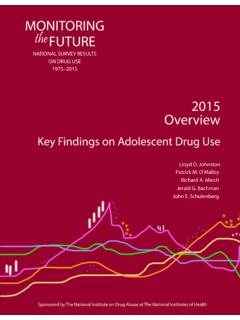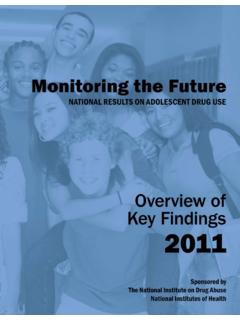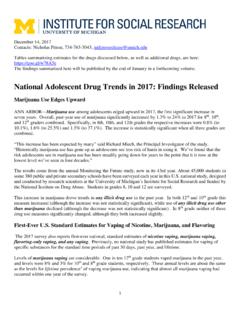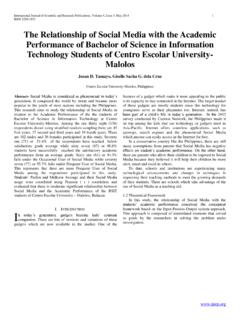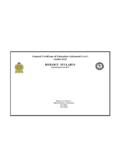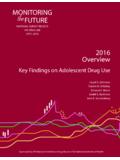Transcription of MONITORING THE FUTURE
1 MONITORING THE FUTURE . NATIONAL RESULTS ON. ADOLESCENT DRUG USE. Overview of Key Findings, 2010. by Lloyd D. Johnston, Patrick M. O'Malley, Jerald G. Bachman, John E. Schulenberg, The University of Michigan Institute for Social Research Sponsored by: The National Institute on Drug Abuse National Institutes of Health This publication was written by the principal investigators and staff of the MONITORING the FUTURE project at the Institute for Social Research, the University of Michigan, under Research Grant No.
2 3 R01. DA 01411 from the National Institute on Drug Abuse. The findings and conclusions in this report are those of the authors and do not necessarily represent the views of the sponsor. Public Domain Notice All material appearing in this volume is in the public domain and may be reproduced or copied without permission from the authors. Citation of the source is appreciated. Recommended Citation Johnston, L. D., O'Malley, P. M., Bachman, J. G., &. Schulenberg, J. E. (2011). MONITORING the FUTURE national results on adolescent drug use: Overview of key findings, 2010.
3 Ann Arbor: Institute for Social Research, The University of Michigan. Institute for Social Research The University of Michigan Ann Arbor, Michigan Printed February 2011. Contents 1. study Design and Methods .. 3. Summary of Key Findings .. 5. Specific Results by Drug Any Illicit 10. Marijuana .. 12. Inhalants .. 14. LSD .. 16. Cocaine .. 18. Crack .. 20. Amphetamines .. 22. Methamphetamine and Crystal Methamphetamine (Ice) .. 24. Heroin .. 26. Other Narcotic Drugs, Including OxyContin and Vicodin.
4 28. Tranquilizers .. 30. Sedatives (Barbiturates) .. 32. Ecstasy (MDMA) and Other Club Drugs .. 34. Alcohol .. 36. Cigarettes .. 38. Smokeless and Other Forms of Tobacco .. 40. Steroids .. 42. Subgroup Differences .. 44. Tables Covering All Drugs 1. Trends in Lifetime Prevalence of Use of Various Drugs for Grades 8, 10, and 12 Combined .. 46. 2. Trends in Annual Prevalence of Use of Various Drugs for Grades 8, 10, and 12 Combined .. 47. 3. Trends in 30-Day Prevalence of Use of Various Drugs for Grades 8, 10, and 12 Combined.
5 48. 4. Trends in Daily Prevalence of Use of Various Drugs for Grades 8, 10, and 12 Combined .. 49. 5. Trends in Lifetime Prevalence of Use of Various Drugs in Grades 8, 10, and 50. 6. Trends in Annual Prevalence of Use of Various Drugs in Grades 8, 10, and 55. 7. Trends in 30-Day Prevalence of Use of Various Drugs in Grades 8, 10, and 60. Contents (continued). 8. Trends in 30-Day Prevalence of Daily Use of Various Drugs in Grades 8, 10, and 64. 9. Trends in Harmfulness of Drugs as Perceived by 8th Graders.
6 65. 10. Trends in Harmfulness of Drugs as Perceived by 10th Graders .. 66. 11. Trends in Harmfulness of Drugs as Perceived by 12th Graders .. 67. 12. Trends in Disapproval of Drug Use in Grade 8 .. 70. 13. Trends in Disapproval of Drug Use in Grade 10 .. 71. 14. Trends in Disapproval of Drug Use in Grade 12 .. 72. 15. Trends in Availability of Drugs as Perceived by 8th Graders .. 74. 16. Trends in Availability of Drugs as Perceived by 10th Graders .. 75. 17. Trends in Availability of Drugs as Perceived by 12th Graders.
7 76. Introduction MONITORING the FUTURE (MTF) is a long-term study of overall proportions of students at each grade level (a). American adolescents, college students, and adults using the drug, (b) seeing a great risk associated through age 50. It has been conducted annually by the with its use (perceived risk), (c) disapproving of its University of Michigan's Institute for Social Research use (disapproval), and (d) saying they could get it since its inception in 1975 and is supported under a fairly easily or very easily if they wanted to series of investigator-initiated, competing research (perceived availability).
8 For 12th graders, annual data grants from the National Institute on Drug Abuse. are available since 1975, and for 8th and 10th graders, since 1991, the first year they were included in the The need for a study such as MTF is clear. Substance study . use by American young people has proven to be a rapidly changing phenomenon, requiring frequent The tables at the end of this report provide the assessments and reassessments. Since the mid-1960s, statistics underlying the figures; in addition, they when it burgeoned in the general youth population, present data on lifetime, annual, 30-day, and (for illicit drug use has remained a major concern for the selected drugs) daily For the sake of nation.
9 Smoking, drinking, and illicit drug use are brevity, we present these prevalence statistics here leading causes of morbidity and mortality, both during only for the 1991 2010 interval, but statistics on 12th adolescence as well as later in life. How vigorously graders are available for earlier years in other MTF. the nation responds to teenage substance use, how publications. For each prevalence period, the tables accurately it identifies the emerging substance abuse indicate which of the most recent one-year changes problems, and how well it comes to understand the (between 2009 and 2010) are statistically significant.
10 Effectiveness of policy and intervention efforts largely The graphic depictions of multiyear trends often depend on the ongoing collection of valid and reliable indicate gradual, continuing change that may not data. MONITORING the FUTURE is designed to generate reach significance in a given one-year interval. such data in order to provide an accurate picture of what is happening in this domain and why, and has A much more extensive analysis of the study 's served that function well for the past 35 years.
